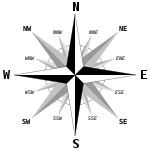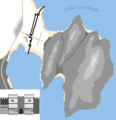Kastoria
Kastoria
Καστοριά | |
|---|---|
UTC+3 (EEST) | |
| Postal code | 521 00 |
| Area code(s) | 24670 |
| Vehicle registration | KT |

Kastoria (
Name
The city is first mentioned in 550 AD, by Procopius as follows: "There was a certain city in Thessaly, Diocletianopolis by name, which had been prosperous in ancient times, but with the passage of time and the assaults of the barbarians it had been destroyed, and for a very long time it had been destitute of inhabitants; and a certain lake chances to be close by which was named Castoria. There is an island in the middle of the lake, for the most part surrounded by water; but there remains a single narrow approach to this island through the lake, not more than fifteen feet wide. And a very lofty mountain stands above the island, one half being covered by the lake while the remainder rests upon it."[4] Although Procopius refers to it as "a city of Thessaly", the description is undoubtedly that of Kastoria, a city on a promontory in a lake.
There are several theories about the origin of the name Kastoria.[5] The dominant of these is that the name derives from the Greek word κάστορας (kástoras, meaning "beaver"). Trade in the animal's fur, sourced from nearby Lake Orestiada, has traditionally been an important element of the city's economy. Other theories propose that the name derives from the Greek word κάστρο (kástro, meaning "castle"; from the Latin word castrum) or from the mythical hero Κάστωρ (Kástōr), who may have been honoured in the area. The word is sometimes written with a C, Castoria,[6] especially in older works. From Greek, the name was borrowed into Turkish as Kesriye. The Bulgarian, Macedonian and Serbian name of the city is Kostur (Cyrillic: Костур). The Albanian name is Kosturi, while the Aromanian name is Castoria.
Municipality
The municipality Kastoria was formed at the 2011 local government reform by the merger of the following 9 former municipalities, that became municipal units:[7]
- Agia Triada
- Agioi Anargyroi
- Kastoria
- Kastraki
- Kleisoura
- Korestia
- Makednoi
- Mesopotamia
- Vitsi
The municipality has an area of 763.330 km2, the municipal unit 57.318 km2.[8] The municipal unit consists of the town Kastoria and the settlements Aposkepos, Kefalari and Chloi.[1]
Districts
- Apózari
- Doltsó
- Dailaki (Myloi)
- Doplitsa
- Kato Agora
- Kallithea
- Lyv
Main streets
- Palaiologou Street
- Nikis Avenue
- Christopoulou Street
- Kyknon Avenue
- Orestion
- Orestiados
- Megalou Alexandrou
- Kapodistria
- Ifaistou
History

Antiquity
Kastoria is believed to have ancient origins.
The ancient town was possibly located on a hill above the town's current location.The Roman Emperor
Middle Ages

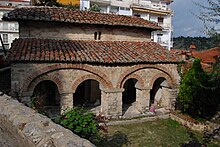

Kastoria itself does not appear, however, until the
Kastoria was occupied by the Normans under Bohemond I in 1082/83.[13] In October 1083, emperor Alexios I Komnenos forced the garrison to surrender, recovering thus the town and convincing many Norman troops, including Peter Aliphas, to enter his services.[14] The town had a significant Jewish presence,[15] most notably the 11th-century scholar Tobiah ben Eliezer.[13]
During the 13th and 14th centuries, the town became contested between several powers and changed hands often.
In the early 14th century, Kastoria was part of the domain of
The Serbian ruler
The town came later under the Epirote ruler Thomas Preljubović, and finally under the Albanian Muzaka family, until it was conquered by the Ottoman Empire in the mid-1380s.[13]
Ottoman era
The
According to the findings of
The city would remain under Ottoman rule (as part of
Doltsó and Apózari


During the Ottoman times, Kastoria attracted a multitude of people from across the Balkans and beyond, resulting in a diverse, multi-ethnic community. As a result, the
These neighbourhoods are characterised by the rich stock of old houses preserved in the shape of autonomous historic buildings, such as the important private
The traditional buildings and manor houses of the “Doltso” and “Apozari” neighbourhoods are threatened by modern development in the city, as well as structural degradation from poor levels of conservation. These sites were included on the 7 Most Endangered list of Europe's most at-risk monuments and sites in 2014.
Interwar period
The Greek census (1920) recorded 6,280 people in the town and in 1923 there were 829 inhabitants (or 242 families) who were Muslim.
World War II
During both
The first Jewish community was a community of
In late March 1944, under Nazi German occupation during World War II, 763 Kastorian Jews were taken prisoner by Nazi troops and sent to
In 2016, a special documentary titled "Trezoros: The Lost Jews of Kastoria"[25] was released with never before seen footage. It has been created by executive producer and director Lawrence Russo (based on his parents' story) and co-director and producer Larry Confino.[26]
Economy


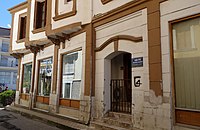

Kastoria is a popular tourist destination and an international centre of
Now there are more than 300 small and big dealers in fur in Kastoria.[
Landmarks


Religious sites
Kastoria is an important religious centre for the
Kastoria used to have two
Museums
The Museum of Byzantine History located on Dexamenis Square houses many examples of Byzantine iconography. The Costume Museum and the Monuments Museum are also located in the city. In the village of Kastanofyto lies the Folklore Museum (Kastanofyto), which preserves folk traditions from the local area.
Kastoria is filled with old manors dating to the Ottoman period, while parts of the old Byzantine walls also stand.
Bridges
Stone bridges are an important part of the traditional architecture of Kastoria. The best known is the bridge of Zouzouli, the bridge of Koromilia, the Koutsoumpli bridge and the bridge in Beriki.
The Bridge of Zouzouli, located in a remote area on the southern tip of the prefecture of Kastoria, is built over the waters of the stream of Zouzouli and connects mt. Smolikas with mt. Voio. It is arched, has a length of 25 meters and a height of 7 meters. Constructed in 1880 by artisans coming from Konitsa. The construction was financed from either a man, in memory of his brother who drowned in the river, or from a ruler who, moved by the drowning of a little girl, wanted to build the bridge.
The bridge of Koutsoumpli is located between the mountains of Voio and Smolikas, over the river of Zouzouli and it previously connected the villages of Eptachori and Zouzouli. Its arch is 14 meters wide, 8 meters high and it has a total length of 33 meters and a width of 2.40 meters.
The bridge in Beriki has a very thin arch and a great height. It was manufactured by master builder Sdrolios, who came from the village of Dendrochori, probably in 1866. Next to the bridge there was possibly a watermill and an inn. Probably, this is where the name of the region came from (inn Beriki).
The bridge of Koromilia is built over the Ladopotamos river and it used to connected the village of Koromilia with the one of Dendrochori. It is arched and has a length of 26 meters, a width of 2.80 meters, a height of 7 meters and an arch opening of 16 meters. It was built in 1865 and consists of limestone and schist slate.
Education
The School of Sciences of University of Western Macedonia with two departments (Informatics and Mathematics) is based in the city,[33] as well as the departments of Communication and Digital Media[34] and Economics.[35]
Cuisine
Local specialities include:
- Giouvetsi (meat with pasta in tomato sauce)
- Garoufa (Grivadisoup)
- Pestrofa (trout)
- Lake fish:
- Sarmades (meatballs wrapped with pickled cabbage)
- Makálo (meatballs with garlic sauce)
- Kolokythopita (pumpkin pie)
- Kremmydopita (onion pie)
- Milk Pie (dessert)
- Sáliaroi (dessert)
Sports
Rowing: London 2012 Olympic Games: Giannis Christou , Christina Giazitzidou
Brazil 2016 Olympic Games: Giannis Christou
Population
| Year | Town | Municipal unit | Municipality |
|---|---|---|---|
| 1981 | 20,660 | – | – |
| 1991 | 14,775 | – | – |
| 2001 | 14,813 | 16,218 | – |
| 2011 | 13,387 | 16,958 | 35,874 |
| 2021 | - | 16,393 | 33,095 |
Location
Climate
Kastoria has a humid subtropical climate (Cfa). As a result of the moderating effect of the lake, it records less extreme temperatures than the rest of Western Macedonia.
| Climate data for Kastoria city (623m) | |||||||||||||
|---|---|---|---|---|---|---|---|---|---|---|---|---|---|
| Month | Jan | Feb | Mar | Apr | May | Jun | Jul | Aug | Sep | Oct | Nov | Dec | Year |
| Mean daily maximum °C (°F) | 7.2 (45.0) |
11.8 (53.2) |
14.7 (58.5) |
17.3 (63.1) |
23.3 (73.9) |
27.8 (82.0) |
30.4 (86.7) |
31.3 (88.3) |
26.4 (79.5) |
19.6 (67.3) |
13.9 (57.0) |
9.2 (48.6) |
19.4 (66.9) |
| Mean daily minimum °C (°F) | −1.1 (30.0) |
0.8 (33.4) |
3 (37) |
6 (43) |
10.2 (50.4) |
14.3 (57.7) |
16.9 (62.4) |
16.9 (62.4) |
13.5 (56.3) |
8.6 (47.5) |
5.8 (42.4) |
2.8 (37.0) |
8.1 (46.6) |
| Average precipitation mm (inches) | 50 (2.0) |
54 (2.1) |
61 (2.4) |
79 (3.1) |
81 (3.2) |
48 (1.9) |
40 (1.6) |
31 (1.2) |
46 (1.8) |
66 (2.6) |
65 (2.6) |
40.5 (1.59) |
661.5 (26.09) |
| Source: http://penteli.meteo.gr/stations/kastoria/ (2019-2021 averages) & (precipitation) | |||||||||||||
Notable people
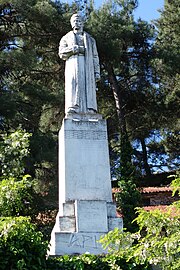
- Tobiah ben Eliezer (11th), author of the Midrash Lekach Tov
- Pavlos Argyriadis (1849–1901), journalist, lawyer and anarchist/socialist intellectual
- Argyrios Vouzas (1857–?), doctor and revolutionary
- Şefik Aker (1877–1964), military officer in the Ottoman and Turkish armies
- Athanasios Christopoulos (1772–1847), poet
- Konstantinos Michail, scholar
- Vasileios Hatzis, painter
- Aristotelis Zachos, architect
- Georgios Theocharis (1758–1843), merchant, revolutionary and diplomat
- Emmanuel bros, partners of Rigas Feraios; executed with him in 1798
- Leonidas Papazoglou, photographer
- Andreas Tzimas, communist politician
- Ioannis Christou, (1983–), Greek rower
- Dimitris Diamantidis (1980–), basketball player
- Christina Giazitzidou (1989–), Olympic bronze medalist in rowing
- Jagnula Kunovska (1943–), politician, jurist and writer
- Nicholas Lambrinides, founder of Skyline Chili, a famous restaurant chain in Cincinnati, USA
- bektashiholy man.
- Sevastos Leontiadis (1690–1765), educationalist
- Lucas Samaras (1936–), artist
- Maria Spiropulu (1970–), experimental physicist
International relations
Twin towns — sister cities
Kastoria is
Gallery
-
Fresco by Onufri at the Holy Apostles church
-
Emmanuel mansion (18th c.), currently housing the Costume Museum
-
A statue of Germanos Karavangelis
-
The Holocaust memorial
-
Geese at theLake of Kastoria
-
Hotel "Kastoria"
-
Pouliopoulos mansion
-
Sts Cosmas and Damian (Anargiroi) church, of 11th century, beside the lake
-
Plan of the medieval Bulgarian fortress
See also
- Castoria (titular see) (Latin Catholic)
- Metropolis of Kastoria (now Greek Orthodox)
- Delinanios Folklore Museum
- Byzantine Museum of Kastoria
- Paleontological and Paleobotanical Museum of Nostimo, a village 25 km (16 mi) from Kastoria
- Kastorianos, folk dance from Greek Macedonia
Notes
- ^ a b "Αποτελέσματα Απογραφής Πληθυσμού - Κατοικιών 2021, Μόνιμος Πληθυσμός κατά οικισμό" [Results of the 2021 Population - Housing Census, Permanent population by settlement] (in Greek). Hellenic Statistical Authority. 29 March 2024.
- ^ )
- ISSN 0362-4331. Retrieved 2022-01-10.
- ^ Procopius "Περί κτισμάτων" "On buildings", book IV, 1.3.
- ^ "Καστοριά – Προέλευση Του Ονόματος (Kastoria – origin of the name)" (in Greek). Δήμος Καστοριάς (City of Kastoria). Retrieved 2008-10-29.
- ^ "K". The Oxford English Dictionary, 2nd ed., 1989, online". dictionary.oed.com. Retrieved 2017-07-15.
- ^ "ΦΕΚ A 87/2010, Kallikratis reform law text" (in Greek). Government Gazette.
- ^ "Population & housing census 2001 (incl. area and average elevation)" (PDF) (in Greek). National Statistical Service of Greece. Archived from the original (PDF) on 2015-09-21.
- ^ ISBN 960-85882-1-9, p.23. (in Greek)
- ISBN 960-7265-01-7
- ^ Catholic Encyclopedia, 1907, s.v. Castoria
- ^ D. C. Samsaris, Dioclétianopoleis – Deux fondations de Dioclétien en Macédoine, BYZANTINA 16(1991)65–72
- ^ ISBN 0-19-504652-8.
- ISBN 978-1-317-49643-4. Retrieved 18 February 2024.
- ^ "Kastoria". jewishvirtuallibrary.org. Retrieved 2017-07-15.
- ISBN 954-427-216-X
- OCLC 22452904.
- ISBN 978-1-884964-02-2
- ^ "Το τζαμί της Καστοριάς και η ιστορία του" [Kursum Mosque of Kastoria and its history]. fouit.gr (in Greek). May 11, 2019. Retrieved November 5, 2022.
- ISSN 0041-4255.
- ^ Kanchov, Vasil. Македония. Етнография и Статистика. I изд. Бълг. Книжовно Д-во, София, 1900; II фототипно изд. "Проф. М. Дринов", София, 1996). 43. Костурска Каза
- ^ Dimitri Mishev and D. M. Brancoff, La Macédoine et sa Population Chrétienne, p. 180
- ^ a b c d Pelagidis, Efstathios (1992). Η αποκατάσταση των προσφύγων στη Δυτική Μακεδονία (1923-1930) [The rehabilitation of refugees in Western Macedonia: 1923-1930] (Ph.D.). Aristotle University of Thessaloniki. p. 76. Retrieved 30 March 2022.
- ^ a b c "The Holocaust in Greece". United States Holocaust Memorial Museum. Archived from the original on 2009-05-06. Retrieved 2009-09-29.
- ^ "Little is known about the former Sephardic communities of Greece. This is one town's story". Trezoros. Retrieved 2022-03-16.
- ^ "Wiped out 'in the blink of an eye': Only 35 Jews survived from a 2,000-year-old Greek community". The Times of Israel. Retrieved 2016-11-27.
- ^ Zikakou, Ioanna (10 August 2014). "This Town Could Die from the Russian Import Embargo to Greece | GreekReporter.com". Retrieved 2019-03-25.
- ^ ISSN 0362-4331. Retrieved 2019-03-29.
- ^ "ραδιοφωνικός χάρτης | Ραδιόφωνο (Greek radio stations, Kastoria)". radiofono.gr. Retrieved 2017-07-15.
- ^ "Εφημερίδα Μακεδονία | Η εφημερίδα της Θεσσαλονίκης (Makedonia newspaper, article of 2008/06/29 by Dimitra Tsapodimou)". makthes.gr. Archived from the original on 2018-10-04. Retrieved 2017-07-15.
- ^ a b Hasluck, F. W.. Geographical Distribution of the Bektashi. The Annual of the British School of Athens, vol. 21, pp 84–124. Pages 106–107: "Kastoria.-- The tekke is situated at the entrance to the town on the Florina road. It is now small and insignificant ... but is said to be ancient and formerly important. It suffered during the persecution of 1826. The chief saint buried here, Cassim Baba, is supposed to have lived at the time of the Turkish conquest, and enjoys considerable local fame as a posthumous miracle-worker. He is said during his lifetime to have converted many Christians by the somewhat crude method of hurling from the hill... a huge rock, which crashed into a church full of worshippers.
Of a second tekke, occupied within living memory, at Toplitza (near the barracks) only the turbe and grave of Sandjakdar Ali Baba remain. The Bektashis also lay claim to the grave of Aidin Baba, in a humble turbe on the outskirts of the gypsy quarter." - ISBN 9789333459358.
- ^ "Schools and Departments". University of Western Macedonia. Retrieved 2022-01-10.
- ^ "Greeting | Department of Communication and Digital Media". Retrieved 2022-01-10.
- ^ "Contact us". Economics Department | Kastoria. Retrieved 2022-01-10.
- ISBN 978-1-78023-863-0.
- S2CID 189889087.
- ^ "Twinnings" (PDF). Central Union of Municipalities & Communities of Greece. Retrieved 2013-08-25.
- ^ "Plovdiv has yet another sister city". Retrieved 2015-03-01.
External links
- Official municipal website (English version under construction)
- Official website of the Prefecture
- Informational Portal for Kastoria
- Kastoria Byzantine Museum
- Dispilio Lakeside Neolithic Settlement
- Byzantine Kastoria through its monuments (10th–14th centuries)
- Kastoria
- Kastoria in visitwestmacedonia.gr

